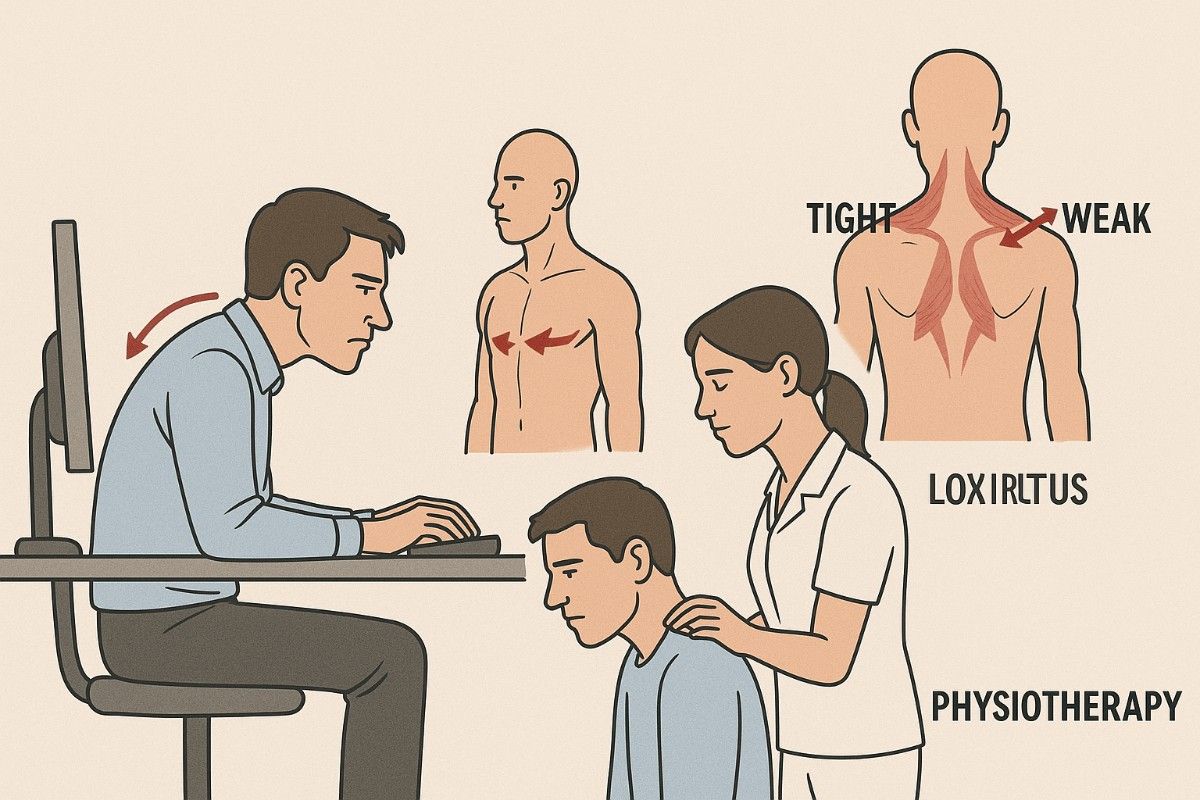Upper Cross Syndrome (UCS) and White-Collar Jobs: Physiotherapy serves as an essential practice both in treating and preventing medical conditions.
Upper Cross Syndrome (UCS) represents a postural imbalance characterized by tight and weak musculature in the neck, shoulders, and upper back region. People working sedentary desk jobs known as white-collar positions often display this muscle tension condition which manifests as a “cross” pattern. The expanding occurrence of UCS and the rising population of office workers emphasize the importance of developing treatment methods through physiotherapy.
The paper investigates how Upper Cross Syndrome develops in association with white-collar occupations while examining physiotherapy’s effectiveness in both treating and preventing this condition.
Upper Cross Syndrome presents as an imbalance between muscle strength and flexibility within the upper body. The term “upper cross” describes the muscle imbalances in the upper body that create an “X” pattern when observed from either the front or back view of the body.
In UCS:
Overactive muscles become excessively contracted which leads to tension and discomfort. They include:
Upper trapezius represents the muscles that reside along the upper region of the back and neck.
The levator scapulae represents muscles located in both the neck and upper back.
Pectoralis major/minor (chest muscles).
Underactive muscles become too weak to provide necessary support for maintaining proper posture. They include:
Deep cervical flexors describe the muscles located at the front part of the neck.
The lower and middle trapezius muscles run across the back of the shoulders.
Rhomboids (muscles between the shoulder blades).
When muscles fail to support body posture properly an imbalance will cause neck pain shoulder pain headaches and poor posture. Untreated conditions develop progressively and their symptoms become more severe over time.
The nature of white-collar work which includes long durations of sitting at desks combined with improper posture results in the development of Upper Cross Syndrome.
Most white-collar professionals spend long durations seated at their desks or computers. Extended sitting periods and suboptimal workplace ergonomics along with incorrect posture during desk jobs greatly increase the risk of developing Upper Cross Syndrome.
1. Prolonged Sitting: White-collar employees typically spend their workdays at desks where they type documents or use computer mice. The forward head posture develops when the head moves forward from its natural position causing stress on neck and upper back muscles. Extended periods of sitting result in rounded shoulders that lead to chest and upper back muscle tightness while reducing the stability muscles around the shoulder blades become weaker.
2. Poor Ergonomics: Numerous office workers neglect to set up their workstations with proper ergonomic standards. Common issues include:
When screens are mounted at incorrect heights workers need to tilt their heads up or down to see properly.
Chairs lacking sufficient lower back support cause people to slump or hunch forward.
When keyboards and mice are positioned too far away from users their shoulders become tense and their arms stretch in awkward positions.
3. Repetitive Movements: Extended typing and mouse usage can create repetitive strain injuries particularly in the shoulder and wrist areas. The muscle imbalance gets worse as the upper trapezius and pectorals become overused while the rhomboids and lower traps stay underactive.
4. Stress: High stress levels are commonly linked to white-collar occupations. The body’s muscles become tense as a result of stress with a special focus on the shoulder and neck regions. Chronic stress worsens UCS symptoms through enhanced muscle tension and reduced circulation to compromised muscles.
Symptoms of Upper Cross Syndrome manifest in white-collar workers through muscle imbalances and pain.
Upper Cross Syndrome shows multiple symptoms which become more severe because of typical white-collar work conditions.
Individuals with this condition commonly experience discomfort in their neck and shoulder regions as well as their upper back which tends to concentrate at the skull’s base or along the shoulder blades.
People often experience tension headaches which occur due to the contraction of upper trapezius muscles and neck tightness.
Those with UCS usually present with forward head position alongside rounded shoulders and upper back kyphosis. Over time these postural changes develop into more visible forms.
The combination of tight chest muscles (pectoralis) and weak shoulder stabilizing muscles (rhomboids and lower traps) creates difficulty for full arm elevation and shoulder rotation.
The combination of muscle imbalances and strain causes UCS patients to feel tired and uncomfortable after sitting or using computers for extended periods.
Physiotherapy functions as a leading treatment option to manage Upper Cross Syndrome.
Physiotherapy stands as a powerful solution for treating Upper Cross Syndrome. Physiotherapy aims to correct muscle imbalances while reducing pain and improving posture to prevent future Upper Cross Syndrome episodes.
1. Postural Education and Correction
Physiotherapists begin treating UCS by teaching patients the principles of correct posture. Through training patients to maintain proper alignment while sitting, standing, and walking physiotherapists help reduce pressure on the neck and shoulders.
Sitting posture: Proper ergonomic setup is crucial. The monitor needs to be positioned at eye level while elbows should form 90degree angles with work surfaces, and feet must remain flat on the ground.
The standing posture should focus on keeping the spine neutral while ensuring shoulders remain relaxed and back muscles unwound.
Workday routines should include regular breaks to maintain productivity and health. During periods of sitting lasting 30–60 minutes take 5–10 minutes to stand up and stretch or take a brief walk.
2. Stretching Tight Muscles
Physiotherapists target stretches for tight muscles linked to UCS with emphasis on the upper trapezius, levator scapulae and pectoralis muscles. Through physiotherapy treatments that enhance muscle flexibility physiotherapists can reduce UCSrelated tightness and discomfort.
During an upper trapezius stretch the therapist instructs a patient to turn their head to a side while the therapist pulls on the patient’s opposite arm to stretch neck and shoulder muscles.
The pectoralis stretch involves standing in a doorway and placing arms against the doorframe to stretch chest muscles which helps to expand the chest and relieve tightness in the pectoralis muscles.
3. Strengthening Weak Muscles
To prevent and treat UCS patients must focus on strengthening their inactive muscles including the deep cervical flexors, lower traps, and rhomboids. These muscles contribute to proper posture and strengthening them enhances body balance which facilitates maintaining correct alignment throughout work tasks.
Performing chin tucks helps build strength in the deep cervical flexors which assists in achieving a neutral head position.
When you squeeze your shoulder blades together you build strength in the rhomboids and middle traps which helps reverse shoulder rounding.
When you perform Prone Y and T raises by lifting your arms while lying face down you strengthen the lower traps and rhomboids.
4. Manual Therapy
Massage and soft tissue mobilization techniques help to loosen tight muscles while simultaneously increasing blood circulation in affected areas. Through this treatment patients can experience less muscle stiffness while also reducing pain in their neck and upper back regions as well as their shoulders.
5. Ergonomic Modifications and Advice
The physiotherapist evaluates the patient’s workstation setup and suggests ergonomic changes. Making minor modifications to your desk setup and screen positioning will substantially reduce the risk of upper body strain. Users should adjust their screen to eye level and select a chair with proper lumbar support while positioning their keyboard and mouse within easy reach.
6. Preventive Measures
Physiotherapists will provide patients with exercises designed to boost upper body strength and teach them how to maintain proper posture. A consistent routine of exercise and stretching helps prevent Upper Cross Syndrome from returning.
Upper Cross Syndrome frequently affects white-collar workers who sit for extended periods in improperly adjusted workstations. Muscle tightness and weakness that characterize UCS creates imbalances which result in pain along with poor posture and reduced mobility. The treatment and prevention of UCS rely heavily on physiotherapy through personalized programs that focus on postural correction along with stretching and strengthening exercises and manual therapy while also providing ergonomic advice. Proper treatment combined with preventive approaches can help UCS patients manage their pain and enhance their life quality while improving posture and minimizing desk work-related problems.
To prevent Upper Cross Syndrome from returning, white-collar professionals must take frequent breaks adjust their workstations and maintain an active lifestyle.
– Dr. Prachi Oza
Physiotherapy, Madhav University

